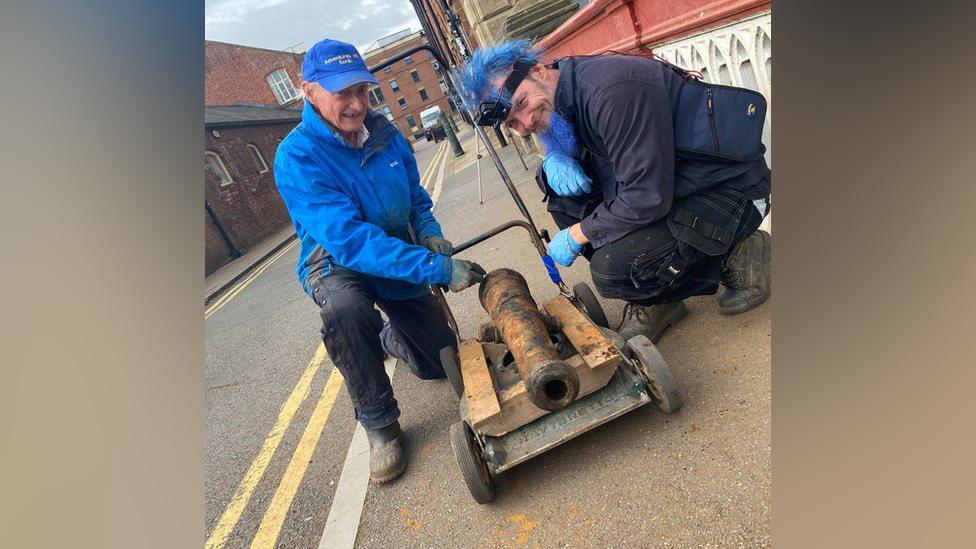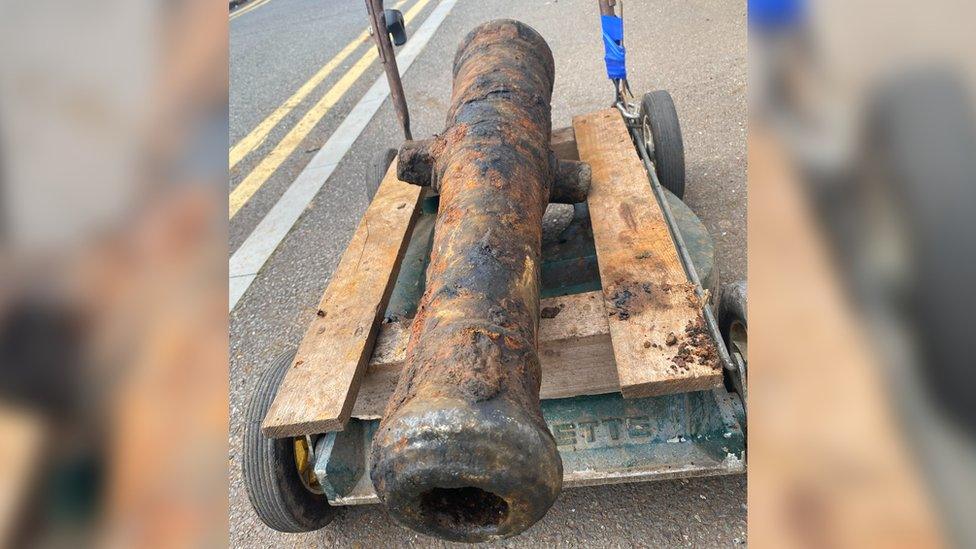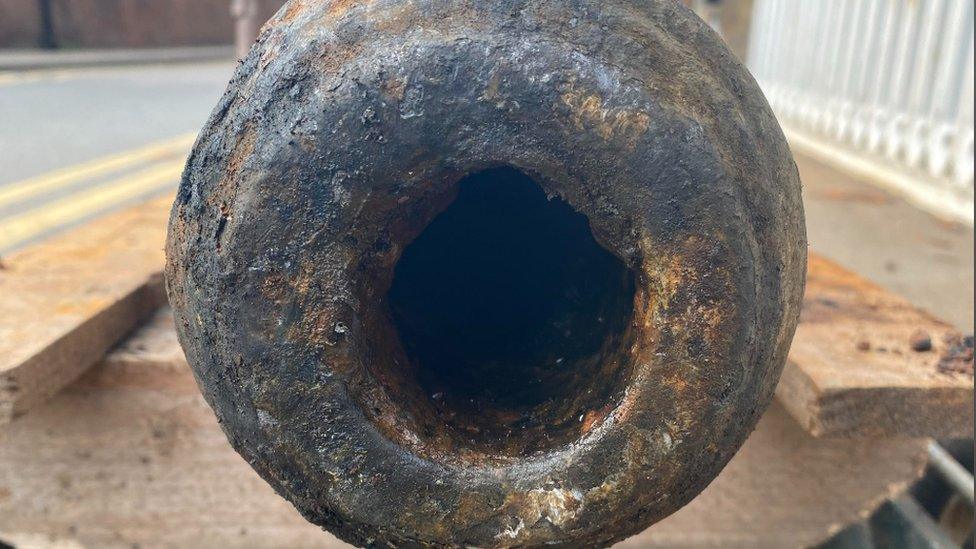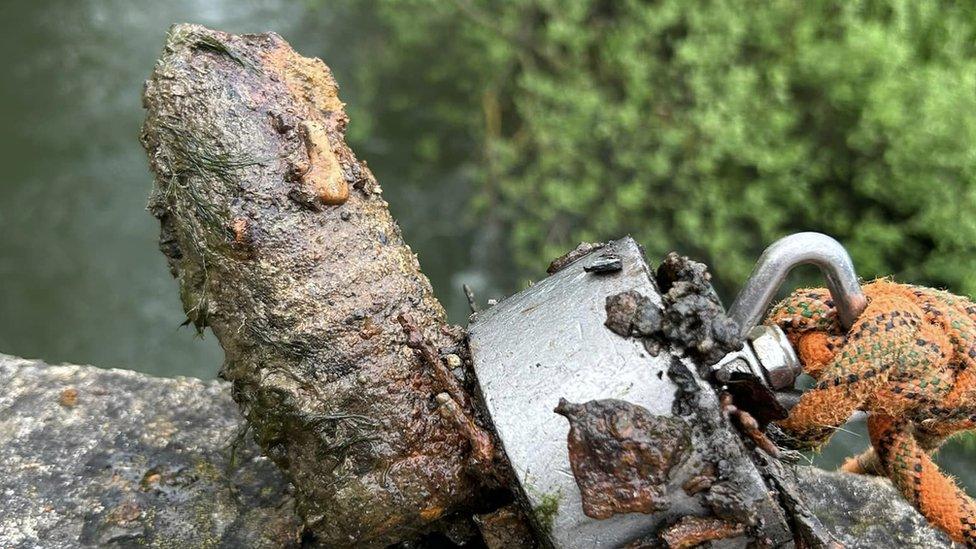Magnet fishermen pull cannon from River Don in Sheffield
- Published

Ray Harper, left, and Dave Jordan with the cannon pulled from the River Don in Sheffield
Magnet fishermen have pulled a cannon from Sheffield's River Don, calling it the "Holy Grail of finds".
Ray Harper, 73, latched onto the object while fishing with three others off the city's Ball Street Bridge on Saturday.
It took them more than an hour to land the 3ft (91cm) artillery piece, with footage later uploaded to YouTube.
Prof John Moreland, of the University of Sheffield, said it would be an "incredible find" if proven to be a genuine historical artefact.

Mr Jordan says the group would like to see the cannon displayed in a museum
Dave Jordan, 46, who was part of the group, said: "Every magnet fisherman wants to pull out a cannon. It's the Holy Grail of finds."
The group were fishing off various parts of the bridge, said the warehouse caretaker from Northampton.
He said: "Ray tends to shout up when he finds something so I can help bring it in, which he did on this occasion.
"Whatever it was on the end of his magnet, it was heavy. We shouted over to the other two and the four of us began dragging it in."
Footage uploaded to Mr Jordan's Adventures with Sonik and Friends, external YouTube channel showed the group using extra ropes and a winch to land the cannon.
When the item was "about half way up" the side of the bridge, Mr Jordan said they "realised what it was".
He said: "We all started giggling like schoolgirls."

The magnet fishermen admit they have "no idea" of the cannon's origins
The group took the item to the nearby Kelham Island Museum, where staff took their details.
Mr Jordan said he decided to take the cannon home with him for safekeeping. He said he was planning to contact the British Museum's Portable Antiquities Scheme to officially report the find on Wednesday afternoon.
The group had "no idea" as to the origins of the cannon, he said.
"It could date back to the English Civil War," Mr Jordan said. "It could have been used to protect or attack a castle that once stood nearby. It could have been a keepsake from the Napoleonic Wars.
"It's only 3ft long. It's possible it was fitted to the side of a boat. We're hoping to find out more."
Prof Moreland, of the university's Department of Archaeology, said a Sheffield Castle inventory from 1586 confirms weapons were stored at the site. The castle was demolished, by order of Parliament, in the mid 1600s.
Mr Jordan added: "We've pulled all sorts out of rivers over the years. We've had a safe with money inside, a stolen police medal, even guns and bombs, which we've had to call bomb disposal out to deal with."
Mr Jordan claimed his hobby, which takes him across the country, benefits the environment, ridding rivers of "old junk".
A Sheffield Museums Trust spokeswoman confirmed a curator had "an initial conversation" with Mr Jordan about the find. He was advised to report the find to his local Finds Liaison Officer, she said.

What are the rules around magnet fishing?
It is not illegal to go magnet fishing on land where hobbyists have sought permission.
But the Canal and River Trust, which owns many of the UK's waterways, has bylaws prohibiting people from removing material.
While it rarely enforces these, it disapproves of magnet fishing, pointing to "rusty and sharp" metal discarded on towpaths and other dangers. It says it prefers people to arrange organised events.
Further information can be found here, external.
Details of how to report archaeological finds, via the Portable Antiquities Scheme, can be found here, external.

Follow BBC Yorkshire on Facebook, external, Twitter, external and Instagram, external. Send your story ideas to yorkslincs.news@bbc.co.uk, external.
Related topics
- Published15 May 2023

- Published14 September 2019

- Published2 November 2022
